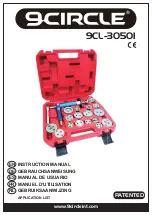
13
Drilling Recommendations
Speeds for Drilling
The speed of a drill is usually measured in terms
of the rate at which the outer periphery of the
tool moves in relation to the work being drilled.
The common term for this is Surface Feet per
Minute (SFM). The relationship of SFM is
expressed in the following formulas:
SFM=0.26 x RPM x Drill Diameter (in inches)
RPM=3.8 x _________SFM_________
Drill diameter (in inches)
In general, the higher the speed the shorter the
drill life. Operating at the low end of the speed
range for a particular material will result in
longer life. The most efficient speed for
operating a drill depends on many variables:
1. Composition and hardness of material.
2. Depth of the hole.
3. Efficiency of the cutting fluid.
4. Type and condition of the drilling machine.
5. Desired quality of the hole.
6. Difficulty of set-up.
Feeds for Drilling
The feed of a drill is governed by the size of the
tool and the material drilled. Because the feed
rate partially determines the rate of production
and also is a factor in tool life, it should be
chosen carefully for each job. In general, the
most effective feeds will be found in the ranges
shown in Figure 11.
Indication of Extreme Speeds/Feeds
Figure 12 shows recommended speed ranges
for high speed steel drills.
A drill that splits up the web is evidence of too
much feed or insufficient tip clearance at the
center as a result of improper grinding. The
rapid wearing away of the extreme outer corners
of the cutting edges indicates that the speed is
too high. A drill chipping or breaking out at the
cutting edges indicates that either the feed is too
heavy or the drill has been ground with too
much tip clearance.
In cases where carbon steel drills are
applicable, the drill should be run at speeds of
from 40 to 50 percent of those given in Figure
12.
Feed Rates per Drill Size
Diameter of Drill
(inches)
Feed per Revolution
(inches)
Under 1/8
0.001 to 0.002
1/8 to 1/4
0.002 to 0.004
1/4 to 1/2
0.004 to 0.007
1/2 to 5/8
0.007 to 0.015
Figure 11
Speeds for High Speed Steel Drills
Material
Speed
(SFPM)
Alloy Steel – 300 to 400 Brinell
20-30
Stainless Steel
30-40
Automotive Steel Forgings
40-50
Tool Steel, 1.2C
50-60
Steel, .4C to .5C
70-80
Mild Machinery Steel, .2C to .3C
80-110
Hard Chilled Cast Iron
30-40
Medium Hard Cast Iron
70-100
Soft Cast Iron
100-150
Malleable Iron
80-90
High Nickel Steel or Monel
40-50
High Tensile Bronze
70-150
Ordinary Brass and Bronze
200-300
Aluminum and its Alloys
200-300
Magnesium and its Alloys
250-400
Slate, Marble, and Stone
15-25
Plastics and similar material (Bakelite)
100-150
Wood 300-400
Titanium Alloys
10-25
Titanium Alloy Sheet
50-60
Figure 12
Содержание J-2210
Страница 7: ...7 Features and Terminology Figure 1 ...
Страница 18: ...18 Exploded View Headstock Cover Assembly ...
Страница 20: ...20 Exploded View Base and Column Assembly ...
Страница 22: ...22 Electrical Connections 1 Phase 230V ...
Страница 23: ...23 Electrical Connections 3 Phase 230V ...










































